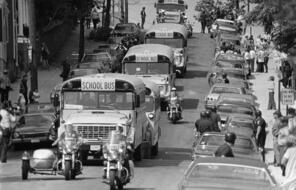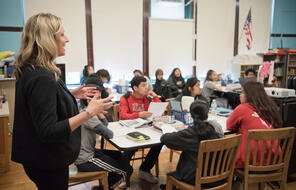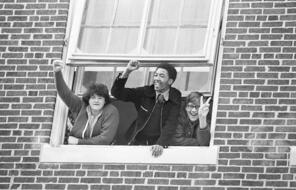Reading
Roxbury Parents Write to Mayor Collins (en español)
An excerpt of a letter to Mayor John Collins from parents of the Roxbury neighborhood of Boston concerned about the conditions in their school district. This resource is in Spanish.
In April 1963, parents in the Henry L. Higginson school district in the Roxbury neighborhood of Boston wrote a letter to Mayor John Collins. They began, “The motivating factor for writing this letter to you — OUR CONCERN FOR THE LACK OF EQUAL EDUCATIONAL OPPORTUNITY FOR THE NEGRO CHILD IN ROXBURY,” and then detailed the following 14 pieces of evidence to support their concerns:
- Roxbury’s schools are 99.8% Negro.
This is DEFACTO SEGREGATION. - At a School Committee meeting in February, Mr. Galeota brought to the School Committee’s attention a basement classroom in the Patrick Lyndon School in West Roxbury. He did not mention the 7 basement classrooms in Roxbury, some of which are unfit for children to be taught in. Yet parents in the Roxbury community pay MORE taxes.
- Overcrowded classrooms in Roxbury — which is the reason given for less money being spent per child in this district. The city average is $275 per year, per child. The Higginson District spends $229; The Garrison District $228. Yet a careful scrutiny of the Annual Business Managers Report reveals that there are other districts, predominantly white, with a large attendance where more money is spent per child than in the Roxbury districts . . .
- Lack of books, pencils, and crayons in the Higginson District. Many parents have purchased crayons for their children . . .
- Lack of stimulation (in the Higginson District) below the fifth grade level for children who can do more. ABLE, MATURE, BRIGHT YOUNGSTERS read, write, or draw in classrooms after assignments are finished or RUN ERRANDS or MONITOR CLASSROOMS. The Supervisor of the District feels Negro “children need drill, drill, and routine mastery work.” Note — nothing to stimulate the mind — just drill, drill, drill . . .
- Educators agree that reading and language skills are best learned in small groups. Most first and second grades in Roxbury . . . learn in classrooms which have Boston’s Maximum of 42 children . . .
- No Negro Principal in the entire school system. There are three or four well-qualified Vice-principals, all of whom are respected by their staff, the parents and the students. There are very few Negro nurses and secretaries. These positions are important in terms of self-identification for a Negro child, and important in terms of the American dream of equal attainment for all groups for the white child.
- Boston offers no orientation program for the teacher coming into the Roxbury area . . . No other section houses citizens of such heterogeneous backgrounds — economically, intellectually, morally, or socially.
Teachers need to understand this situation, and the reasons for it. Roxbury has many sincere, dedicated, hard-working teachers, who are doing a good job, in spite of overcrowded classrooms and a lack of help for children with special needs. However, there are many teachers who do not enjoy teaching Negro children, but who TOLERATE them, and who do not believe in their educability. These teachers should be weeded out and sent to other districts. A teacher has to like a child and believe in his educability for education to be effective. - Lack of permanent teachers in Roxbury School Districts — there are many temporary teachers. Lack of substitutes. We have been assured by Miss Sullivan that children in the Higginson District will never supervise classrooms again. (Previously 4th and 6th grade youngsters had monitored classrooms all day.)
- Lack of qualified, carefully chosen teachers for the “special classes.” In some instances, these classes exist for the personal comfort of the teacher who performs baby-sitting duties while the children “play” or carry out her wishes.
- Supposedly there is no time in the school day or money in the budget for exposing our children (1st – 5th grade) to museums, concerts, book fairs, exhibits, etc. . . .
- The School Issue Deposit of books in the individual classroom [books available in individual classrooms for students to read] (which was cut out of the library budget and never reinstated) should be replaced or mobile libraries set up in our schools. For some children the School Issue Deposit was their only introduction to the world of "reading for pleasure.”
- Standards in the predominantly Negro schools in Roxbury are very low . . . Low standards in Roxbury are borne out by the wide degree of tutoring (from 1st grade through high school) which parents find necessary to provide for their children so that they can compete with youngsters from other parts of the city on a junior high or senior high level, and so that children do not become scholastically lazy. Many youngsters who receive all A’s and B’s throughout their school years in the Higginson or Julia Ward Howe districts flunk out at Boys’ or Girls’ Latin or don’t come into their own until the second or third year. Concerned parents hopefully supply stimulation at home and through other media to offset the lack of stimulation in school.
- Needs of children with special problems are not met. The child who needs individual attention from a first-grade teacher (who has already 35 plus children) because of deep-rooted problems is often carried along until he is 11 or 12 years of age in the 4th grade. Nothing has been done for him. His problems are intensified; he constantly disrupts the class and annoys the teacher and the other children . . . 1
- 1Quoted in Ruth Batson, The Black Educational Movement in Boston: A Sequence of Historical Events (Boston, MA: Northeastern University, 2001), Addendum 85b.
The resources I’m getting from my colleagues through Facing History have been just invaluable.
—
Claudia Bautista, Santa Monica, Calif













